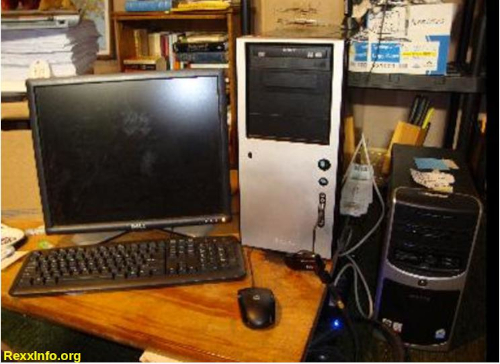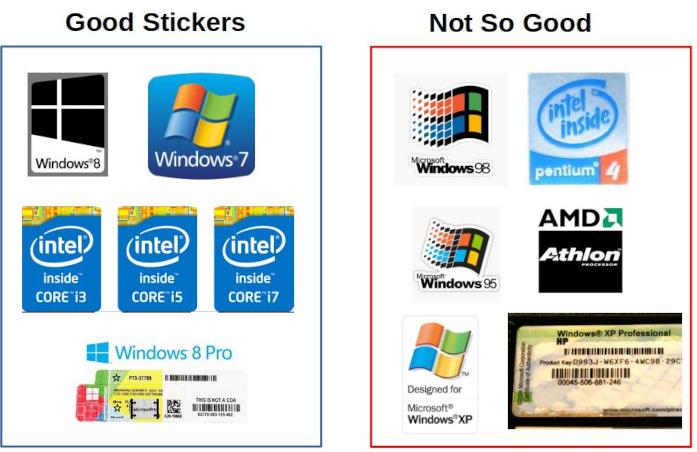How to Get a Free Computer -- Build One From Cast-offs!
by Howard Fosdick Last updated 2025 © RexxInfo.org -- Share this under the open source CC-BY-ND license. (Please do not alter contents.)

Not so long ago, personal computers advanced so quickly that you had to a buy new one every several years to keep up. Unless you had an up-to-date machine, you couldn't run current software.
That's no longer the case. With free open source software, any computer made since about 2010 can do everything the typical home user wants.
You no longer have to buy new. You may not even have to "buy" at all. You certainly don't have to own current hardware.
In this article I'll tell you where and how to get used computers -- either for free, or at very low cost.
My companion article tells how to reburbish that mature hardware into a perfectly good computer, running current software, and capable of all the tasks required of any home computer.
Together, these two articles show you -- step by step -- how to build a fully capable machine for minimal cost. No background in computer hardware is required.
I'll include "trade secrets" I've learned in twenty years of computer refurbishing. It benefits both you and the environment to keep working equipment in service for as long as it performs well and can do the job.
Sound like a fun project? Let's start...
Where to Get Your Free Computer
Here are ways friends and myself have gotten free or low-cost computers and parts:
* Your own garage, basement, or attic.
* Ask friends and family for their old computers.
* Ask friends or co-workers at work --
* This works especially well if they are white-collar professionals. These folks are often locked into the Windows "upgrade treadmill". They discard good working computers that don't run current Microsoft software. Of course, these make fine Linux computers.
* IT workers are another great resource. They often prefer state-of-the-art technology and will often give away good PCs.
* Recycling centers will often let you poke around and grab a machine or two. Especially if they're run by local government, where employees have no incentive to "police the inventory". (Those run by corporations often have stricter rules.)
* A public "ask" can work --
* Place a free ad on Craigslist.
* Ask on social media.
* Sometimes posting a notice on a bulletin board at church, school, work, the local coffee shop, or the public library will net you a machine.
* Freecycling organizations redistribute used items for free. That's their entire purpose. The goal is to reduce waste and landfill accumulation.
To find a local group near you, click on these links:
* You can also google for "computer refurbishing organizations" and find a number of charities that refurbish and reuse donated computers.
In Your Favor
Why would anyone give away a perfectly good, working computer? Assuming you're in the United States, two big forces work in your favor.
(1) Environmental regulations. Most localities forbid residents
from placing electronics into their trash.
So people are often looking for somewhere to discard their previous computers. Most will welcome your offer to haul their older devices away, rather than going to the trouble of locating a recycling center and lugging their equipment to it themselves.
In fact, a CNET survey showed that 31% of US adults hold onto old computers and electronic gear because they're not sure what to do with it. So try all those possibilities I mentioned above, and almost certainly you'll locate some no-longer-used tech that somebody will gladly give you.
(2) Planned obsolescence. Microsoft purposely obsoletes mature hardware when they release new versions of Windows. For example, when Windows 11 came out, many understood that the computers they bought with Windows 7, 8, 8.1, and even 10 would not run 11.
As a result, a wave of mature computers flooded the town dumps. The beauty of this -- from your standpoint -- is that these are working computers! They weren't discarded due to hardware failure. People tossed them simply because they thought they couldn't run Windows 11.
Of course, those junked computers run Linux and free open source software just fine. (That's because Linux does not impose new hardware requirements to upgrade versions. Another reason is that Linux requires significantly less resources to run than Windows. )
Every time Microsoft introduces a new Windows version, you have a chance to pick up free working hardware. Expect another wave due to the arrival of Windows 12.

Wait! There Are Some Perfectly Good Computers In There! (Courtesy: EscrapRecycling, ElectronicReusingAssociationUS)
Better Neighborhoods Discard Better Computers
To some extent, whether you can find good cast-offs depends on geography. The economic level of the neighborhood you search in determines the age and quality of the computers people discard.
Visit the village recycling center in a well-off suburb, and you'll see relatively recent computers tossed by white collar and IT professionals who require state-of-the-art equipment for their jobs.
You'll also find that many people will discard an otherwise good five- to ten- year old computer because one part no longer works. You'll find perfectly good machines that have a broken disk drive, or displays that can easily be fixed simply by soldering in a new 50 cent capacitor.
Visit a poor neighborhood and the machines you'll find will be older, with more broken parts. Economically pressed folks keep their computers in service longer.
So focus on better-off towns and neighborhoods for the greatest success.
You're Doing a Good Deed
It's worth noting that you're doing the earth a good deed when you keep an old computer in service, rather than buying a new one.
Making computers consumes an astonishingly wide range of raw materials, some of which are pretty rare. They include toxins that are really harmful when dumped in landfills.
So where do computers end up when their service time ends?
Less than a quarter are properly recycled. Many end up in landfills.
Most computers that you are told are "recycled" are not reused. Nor are they dismantled for their useful parts.

(Courtesy: Shoaib Mir @Slate.com)
Often they're shipped to developing nations and destroyed into their constituent raw materials. Only the raw materials are recycled.
This work is usually performed under unsafe conditions.
Keeping computers in service longer does not solve these problems.
But it definitely reduces their scope and impact.
The longer computers stay in service, the lesser the rate at which new ones add to the problem. That's enormously beneficial.
What to Look For
To be successful at acquiring useful computers you need to know what to look for.
Look for any stickers and license labels on the computer. Also look for manufacturer's labels, which often
tell when a computer was made.
For desktops, check the front and back. For laptops, check the bottom and open them up to check next to the keyboard.
Stickers tell you what version of Windows the computer shipped with:

Good and Bad Stickers Tell the Tale -- RexxInfo.org (Stickers courtesy the vendors)
Windows 7 or newer is good. That's usually a multicore computer, or at least a late-model dual core.
Machines predating Windows 7 can serve specific use cases. My my companion article tells how to refurbish them.
But they're too old to make good general-purpose platforms for home computing.
So here's what you're after:
- Multicore CPUs are good
- Dual core are marginal for general purpose use
- Single core processors can fulfill specific uses. But they are unacceptable for creating a good general-purpose home computer (though their peripherals like mice, keyboards, headphones, speakers, etc. are often still useful).
Multicores date back to roughly 2010 and dual-cores to about 2005. (Keep in mind that the generations overlap by a couple years.)

Computer Generations (By the author)
If you have the time when picking up used computers, look up their makes and models on your cell phone. Google for their "specs" or "specifications." This will give you a quick assessment of what you're looking at.
What to Take
Always take more than a single computer if possible.
Why? You'll find that many people remove (or destroy) their disk drive. Or perhaps they'll remove the memory. Or maybe one computer has a hardware defect that another addresses.
Taking several computers greatly increases the chances you can build one really nice machine. Ideally they should be from about the same era so that their parts are maximally interchangeable.
Remember to take the cords. You need two for desktops: one for the monitor, and one to connect the computer to the wall socket.
For laptops, find the power adapter that matches it. Most of these are model-specific, and if you can't find it when you take the laptop, you'll be on the hook for securing one later.
(You can always buy an inexpensive universal laptop adapter, but it's much easier if you secure the one made for the laptop when you grab the laptop.)
And make sure that laptop adapter is complete. Some come as two pieces -- cords that snap together. You'll need the complete adapter to make it work.
If you're building a desktop and need a display, take a couple. It's pretty surprising, but many people toss perfectly good screens because they get a new one bundled when they buy a new computer.
If you end up with an LCD monitor that doesn't work, be aware that most fail due a leaky capacitor. People throw out displays all the time that only need a new capacitor. You can easily replace this $5 part if you have a soldering tool. Just watch a couple how-to videos.
Don't forget to take all the peripherals you may need -- mice, keyboards, speakers, headphones, microphones, cameras, thumb drives, internal disk drive cables, and power strips, for example. Be sure to take duplicate peripherals as some may be broken.
Even if these items are from really old computers, many will likely work fine in your build. A 20-year-old mouse or keyboard will work just fine with today's computers. Just clean it.
If you end up needing to purchase a display, in the U.S., Goodwill shops are a great source of very inexpensive used monitors. In my town, they sell them for $10 to $15. Most Goodwill stores also carry keyboards, mice, speakers, and other peripherals. These go for $5.
Once you've got your computers, visit the manufacturers' websites to download documentation specific to those models. These manuals provide useful machine-specific documentation.
Building Your Computer
Okay, you've collected everything you think you need. Ideally that includes a couple similar computers and all their peripherals.
Now you need to do two things:
- Verify what you have and determine what works
- Build your computer
Click here for step-by-step build instructions.
(To rebuild a computer that predates Windows 7, click here for step-by-step build instructions).
-----------------------------------
====> Like this free article? Spread the link love to Slashdot, LXer, or your favorite social media. Thank you.